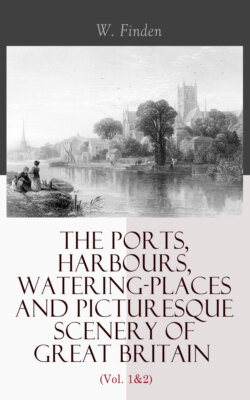Читать книгу The Ports, Harbours, Watering-places and Picturesque Scenery of Great Britain (Vol. 1&2) - W. Finden - Страница 13
На сайте Литреса книга снята с продажи.
BURLINGTON QUAY.
ОглавлениеTable of Contents
The Engraving of Burlington Quay, from a painting by Balmer, presents a view of the entrance to the Harbour from the eastward. To the right is seen the inner part of the Old Pier, as it appeared after the great storm of 17th and 18th February, 1836. In front are the houses at the end of Quay Street, and to the left is the South Pier; between this and the shore two ships are perceived aground at the entrance of the inner harbour, which is nearly dry at low water. In the storm above alluded to, great injury was done to the old North Pier, and part of one of the houses to the right was washed down by the violence of the sea.
Burlington Quay lies about a mile to the north-east of the market-town of Burlington, and at the bottom of a bay of the same name. It is in the East Riding of Yorkshire, and is about two hundred and eight miles from London, forty from York, and twenty from Scarborough. The earliest mention of it as a harbour occurs in a mandate of King Stephen, addressed to the Sheriff of Yorkshire, commanding him to allow the Prior of Burlington to hold it on the same terms as Walter de Gaunt, and Gilbert, his ancestor, had held the same. During the time that it was in the possession of the Priors of Burlington, it seems to have been an inconsiderable place; but subsequently, as the coal trade between London and the northern parts of the kingdom increased, it began to be of greater importance as a harbour, in consequence of its affording shelter in stormy weather to vessels engaged in that trade. In 1546, an act was passed imposing a duty for erecting the piers and keeping them in repair; and, in 1614, a second act was passed, upon a petition from the merchants and ship-owners of the eastern coast, imposing a duty, for the same purposes, on all coals shipped at Newcastle. Since 1614, several other acts have been obtained, authorising the levy of duties and tolls for the purpose of improving the harbour and repairing the piers; and since 1816, the sum thus collected has averaged about £1,750 per annum.
The harbour at Burlington Quay is almost entirely the work of art, as the small stream which there runs into the sea is scarcely sufficient to turn a mill. Its locality seems to render it one of the most appropriate stations for a harbour of refuge between the Frith of Forth and Yarmouth Roads, more especially in gales of wind from the north-eastward; but unfortunately it can only be entered by comparatively small vessels, as the depth of water at the entrance is only from ten to twelve feet at neap-tides, and from fourteen to sixteen feet at springs. The harbour is also so small, that fifty sail of colliers taking shelter there would render it extremely crowded.
The history of Burlington Quay, considering it as a separate place from the town of Burlington, is extremely meagre. The most remarkable event which its annals record is the landing there of Henrietta Maria, Queen of Charles I., on her return, in 1643, from Holland, whither she had been to conduct her newly-married daughter to her husband, the Prince of Orange, and where she pledged part of the crown jewels in order to obtain money to purchase arms for the Royalists. The Queen, who was attended by a convoy of Dutch men-of-war, under the command of Admiral Van Tromp, landed at Burlington Quay, on the 22nd of February. The Parliamentary admiral, Batten, who had been cruising, with four ships, for the purpose of intercepting her, having received intelligence of her arrival, sailed into the bay and began to cannonade the town. Several of the shot struck the house in which the Queen was lodged, so that she was obliged to leave it, and take shelter in a ditch in a neighbouring field. A serjeant was killed near her, and the Parliamentary admiral continued his fire until the reflux of the tide and the threats of Van Tromp compelled him to desist.
Burlington Quay is much frequented in summer as a bathing-place; and many persons prefer its quiet and retirement to the greater gaiety of Scarborough. The beach, to the northward of the quay, affords excellent opportunities for bathing, and the walks and rides in the vicinity are extremely pleasant. A visit to Flamborough Head, which is only about five miles distant, forms a highly interesting excursion either by land or water.
The market-town of Burlington, or, as it is frequently spelled, Bridlington, is situated about a mile to the north-westward of the quay.
FLAMBOROUGH HEAD.
